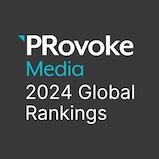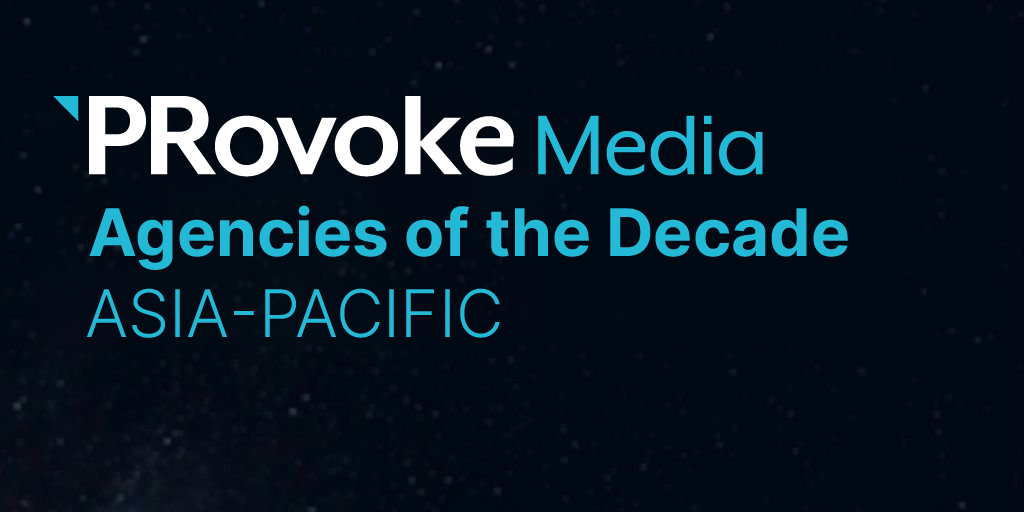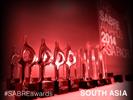
 Podcasts
PodcastsCatch the latest PR news & updates with PRovoke Media's PR Podcasts. Lifting the lid on key industry stories & trends, join our listeners of PR podcasts today.
 Videos
VideosLatest video interviews and campaigns from PRovoke Media, previously known as the Holmes Report.
Long-form journalism that analyzes the issues, challenges and opportunities facing the business and practice of PR.
 Profiles & Interviews
Profiles & InterviewsExplore PR profiles and interviews with leaders from the marketing and PR worlds.
 Crisis Review
Crisis ReviewPR Crisis & Business Crisis review. PRovoke Media's annual analysis of the top reputation crises to rock the corporate sector. Read on here.
 Coronavirus
CoronavirusPRovoke Media's coverage of the Covid-19 crisis, focusing on corporate communication, public affairs & PR industry fallout.
 Trend Forecasts
Trend ForecastsPRovoke Media's PR Trends round up. PRovoke Media's annual forecast of PR trends and news that will impact the PR world in the year ahead...
 Social & Digital
Social & DigitalDedicated to exploring the new frontiers of PR as it dives deeper into social media, content and analytics.
 Technology
TechnologyOur coverage of key technology PR trends and challenges from around the world of digital communications.
 Consumer
ConsumerFrom brand marketing to conscious consumerism, coverage of key marketing and PR trends worldwide.
 Employee Engagement
Employee EngagementPRovoke Media's coverage, analysis and news around the rapidly-shifting area of employee engagement and internal communications.
 Sports Marketing
Sports Marketing Sports PR news, diversity & inclusion trends, views and analysis from PRovoke Media. Subscribe today for the very latest in the world of sports communications.
 Global PR Agency Rankings
Global PR Agency RankingsPRovoke Media's definitive global benchmark of global PR agency size and growth.
Enter PRovoke Media's 2024 Global 250 Agency Ranking and/or our Agencies of the Year competitions now.
 Agencies of the Year
Agencies of the YearPRovoke Media's annual selections for PR Agencies of the Year, across all of the world's major markets.
 Innovator 25
Innovator 25PRovoke Media profiles marcomms innovators from across North America, EMEA and Asia-Pac.
 Creativity in PR
Creativity in PRIn-depth annual research into the PR industry's efforts to raise creative standards.
 Asia-Pacific Communication Index
Asia-Pacific Communication IndexAPACD/Ruder Finn annual study of Asia-Pacific in-house communications professionals.
 SABRE Awards
SABRE AwardsThe world's biggest PR awards programme, dedicated to benchmarking the best PR work from across the globe.
 PRovokeSummit Global
PRovokeSummit GlobalThe biggest PR conference of the year, a high-level forum designed to address the critical issues that matter most.
 PRovoke Media Regional Series
PRovoke Media Regional SeriesA global network of conferences that explore the innovation and disruption that is redefining public relations.
 Agencies of the Year
Agencies of the YearUnrivalled insight into the world's best PR agencies, across specialist and geographic categories.
 Roundtables
RoundtablesOur Roundtables bring together in-house comms leaders with PR firms to examine the future of communications.
 Agency Playbook
Agency PlaybookThe PR industry’s most comprehensive listing of firms from every region and specialty
.jpg) All Jobs
All JobsFind the latest global PR and communications jobs from PRovoke Media. From internships to account executives or directors. See all our PR jobs here.
PRovoke Media's editorial series published in collaboration with partners.

Winners were counted down at the Asia-Pacific SABRE Awards ceremony, taking place virtually on 24 September.
The PR suffix might be gone (to the chagrin of some of the firm’s senior leaders) but Ogilvy continues to serve as the benchmark by which other regional public relations networks are measured in Asia-Pacific. After entering the decade as the biggest global PR agency in the region. Ogilvy's Asia-Pacific PR unit not only overtook its US earnings, but also held on to top spot in this part of the world despite fierce competition — submitting year after year of growth to nudge towards the $200m mark. The credit for that must go to veteran leader Scott Kronick's largely stable senior team, which oversees more than 1,000 staff working across 26 offices in 15 countries, giving it the largest regional footprint of the MNC firms, led by consistent strength in Greater China, Australia, Japan and Southeast Asia.
Today, the ‘PR & influence’ domain, as we must now call it, functions as the largest profit contributor to Ogilvy group in many markets. Indeed, while Ogilvy’s ‘refounding’ makes much of breaking down barriers between silos, it is easy to view Asia-Pacific as the template for this thinking, given the number of Ogilvy PR executives that now lead the broader group in such markets as Beijing (Selina Teng), Guangzhou (Frangelica Liang), and Vietnam (Dieucam Nguyen). There has been particular attention paid to Ogilvy PR’s integrated offering, which includes a formidable digital and social media practice (numbering 400 executives and up 12.5% last year as the group’s best-performing unit), along with strategic depth in such areas as public sector and public affairs, technology, consumer marketing and financial communications. It is worth noting that, after 35 years in the region, Ogilvy’s PR operation continues to either be the largest, or within the top three, in a slew of markets, including China, Australia, Hong Kong, Singapore, Taiwan, the Philippines, Vietnam, Indonesia and Malaysia.
And the firm's creative reputation remains in fine shape — there is surely no agency that has won more SABRE Awards over the past decade — including multiple Best in Show accolades for such clients as the British Council, Transparency International and Jala Group, from a roster that also includes Huawei, KFC, Pizza Hut, Nestle, Shiseido, Tencent, Unilever, Dell, OCBC Bank, HSBC and Mondelez. — AS
Remarkably, it took Weber Shandwick until 2014 to win its first Network of the Year accolade in Asia-Pacific, reflecting the impressive progress required to the make the Interpublic agency a credible force in this region. In the six years since, Weber Shandwick made up for lost time by winning the award on a further two occasions —ending the decade as the region's most successful network, once geographic and specialist Agency of the Year Awards are factored in too. All of which is testimony to the team assembled under former Asia-Pacific chairman Tim Sutton and current CEO Baxter Jolly, which included such names as vice-chair and North Asia MD Tyler Kim in Korea; former vice-chair and China president Darren Burns (now at Golin); client experience chair Vanessa Ho Nikolovski in Singapore; and recently-departed chief strategy officer Ian Rumsby in Australia.
All of which helped revenue grow rapidly to $120m, thanks to considerable geographic breadth and specialist depth. The firm’s local market leadership, overseeing some 900 people across 10 markets, also reflects Weber’s preference for homegrown leaders, including David Liu and Lydia Lee in China, Albert Shu in Hong Kong, Valerie Pinto in India, and Takeo Nishitani in Japan. Greater China continues to account for around half of its regional revenues, with more than 400 people across offices in Beijing, Shanghai, Taiwan and Hong Kong. Under CEO Valerie Pinto, meanwhile, Weber Shandwick has transformed its Indian operation to an impressive extent, moving from a traditional PR player towards a highly creative, integrated powerhouse that is responsible for some of the country’s most memorable campaigns. In North Asia, Kim oversees two markets (Japan and Korea) that have emerged as the firm’s most reliable sources of growth in recent years. And, in Singapore, Ho Nikolovski is responsible for an office that serves as the key hub for Weber Shandwick’s impressive regional client roster, which now includes 18 assignments worth more than $1m, including GM, Nestle, IBM, Nike, Mastercard, Pfizer, Oppo, Swatch Group and ExxonMobil.
But the numbers don’t tell the full story of Weber Shandwick’s transformation in Asia-Pacific. There has been sustained evolution of the firm’s digital and creative capabilities, including an expanded analytics practice that has underpinned growth across consumer and corporate. Meanwhile, healthcare has emerged as the firm’s fastest-growing practice area in several markets, while technology is a particularly strong point when it comes to Weber Shandwick’s focus on Asia-domiciled clients, which include Hanwha, NTT Docomo, Oppo, Tencent, Samsung and Alibaba. And Weber Shandwick's culture remains considerably more stable than most, a tribute to the collegial mindset instilled by Jolly and his team. Weber Shandwick's campaign work during the decade further reflects this progressive mentality, fusing digital, creative and classic storytelling to notable effect for an agency that has dominated our Global Creative Index. — AS
Madan Bahal’s Adfactors began the decade as one of the leaders in the Indian public relations market, with a team of more than 250 professionals in a dozen main offices across the sub-continent and fees of around $11 million. Its reputation was built primarily on its expertise in high-stakes corporate and financial communications, which made it a preferred partner for many of the US and UK agencies handling global financial transactions with an Indian component, and its burgeoning capabilities in crisis management.
The decade saw impressive growth, and it ended last year with fee income of more than $35 million, enough to hold on to its place among the world’s 70 largest PR firms, supporting a trio of the biggest names in the market (Tata Group, Mahindra Group, Godrej Group) as well as a host of multinationals. But it also saw Adfactors diversify its business considerably: most notably, moving beyond the corporate arena to add expertise in digital and social media, and in areas such as corporate social responsibility and purpose. Those capabilities have helped the firm establish itself as a leader on the awards circuit, picking up 32 SABRE nominations last year (winning four of them) and cracking the top 10 in our Global Creative Index.
But the Adfactors story is not just one of exceptional growth and surprising creativity. The firm is one of the best managed in Asia, with a particular focus on a formal professional development process that has been a key factor in helping it stay ahead of market trends. As a result, it has won Agency of the Year awards not only in India, or even in Asia, but also at the global level: it was our Global Financial Consultancy of the Year in 2015 and our Global Corporate Agency of the Year in 2016. — PH
AKA launched in 2009, so the Singapore firm's progress neatly encapsulates a decade in which, for the first time, big clients began to trust boutiques as a viable alternative to bigger network options. As veterans of Grayling, of course, Amy Wright and Kate O'Shea knew all about the issues plaguing MNC PR firms. At AKA, they addressed many of them — providing senior-level counsel combined with an intense focus on creativity, absent of the usual silos that bedevil larger players. And while it was not all plain sailing, by the second half of the decade, AKA had truly hit its stride, winning Consumer Agency of the Year honours on three occasions along with multiple nods in the Best Agency to Work For category.
By 2019, AKA was submitting another record-breaking year, growing revenue by 34% to reach S$7.3m, with headcount up 29% to 40 staffers. Neither has the firm's focus on growth outpaced its enviable employee culture, which includes a renewed focus on listening, transparency and mentorship, along with increased flexibility and investment in training and development, particularly as it relates to creativity. Unsurprisingly, AKA has also grown its senior team by hiring Julia Wei, who took on the newly-created role of managing partner after previously working at Lazada and TSLA.
After making its name as one of Diageo's key PR firms, AKA's client portfolio has expanded to include a host of major corporates and public sector clients, for whom it brings a distinct creative mindset. These include Jetstar, the EDB, British Council, Manulife, Discovery Networks APAC, Nike, Deliveroo and Electrolux SEA, along with newer additions such as Facebook and WhatsApp. And the firm's consistent performance as one of Asia's few regular contenders in our Global Creative Index provides further justification for its inclusion on this list, thanks to award-winning work for such clients as Jetstar, Impossible Foods and Electrolux. — AS
Established in 1996, when public relations in China was still very much in its infancy, by the beginning of the decade what was then BlueFocus was by some distance the largest independent public relations firm in the country, with more than 600 employs in 21 offices and revenues of around $32 million. That made it a tempting acquisition target for foreign multinationals, who struggled to match its geographic reach or cultural relevance, and it would not have been surprising to see the firm absorbed by one of its largest Western rivals. Instead, it elected to join them.
And so today, Oscar Zhao’s company is one of the top 10 public relations businesses in the world, with 2019 fee income (per our Global Ranking) of more than $330 million. While the rapid growth that saw it emerge as the world’s largest non-US agency has stagnated over the past three years and the firm elected to spin off its international brands—including Citizen Relations and We Are Social—into a new listed company, BlueFocus continues to be a formidable force in China, with 1,400 employees across offices in Beijing, Shanghai, Guangzhou, and Shenzhen and a host of second-tier cities.
BlueFocus has responded to challenging market conditions in its domestic market with several initiatives designed to ensure that it retains its leadership position. As a pioneer in the digital communications revolution in China, BlueFocus was well-placed to take advantage of shifting demand, and has also been a first-mover in adopting new technologies such as artificial intelligence and virtual reality, while the firm’s data and analytics capability has helped it land multiple Digital Agency of the Year honours (including Global in 2017), fuelling its development of disruptive work for clients, and ensuring the firm stays one step ahead of new trends itself. — PH
Dentsu the fifth largest advertising company in the world, bestrides the Japanese communications industry like a colossus, wielding a tremendous influence over the Japanese media. And when the decade began, Dentsu’s public relations operation was regarded as a powerhouse in part because of the influence wielded by its parent company made it one and in part because the Japanese PR industry was focused primarily on media relations.
But Dentsu has evolved along with the Japanese—and global—public relations business, first developing digital and social media expertise and then content creation capabilities that made it much more than just a publicity shop. Today, it is a strategically important part of a fully integrated agency, helping clients take earned-first ideas and develop them across multiple channels and platforms. The quality of the resulting work has been increasingly steadily over the course of the decade, and Dentsu ended the year as the number six agency on our Global Creative Index, one of the most awarded agencies in the world — regularly contending for Best in Show at the Asia-Pacific SABRE Awards and landing numerous Global SABRE winners.
And Dentsu remains a standout in terms of its corporate work, its traditional media relations capabilities, and its leadership in the Japanese marketplace. In 2019, the firm worked with 38 Fortune Global 500 companies and 81 Nikkei 225 index companies—with a roster of clients that includes many of Japan’s leading institutions: the Tokyo Metropolitan Government, the Ministry of Foreign Affairs, the Japanese Cabinet Office, the Ministry of Defense, the Japan National Tourism Organization, and corporates Philip Morris, Procter & Gamble, and Shiseido. — PH
At the start of the decade, the idea that Microsoft would entrust a fledgling, independent PR boutique with its Singapore account would have struck many as fanciful. But Microsoft knew what the market knew, that by hiring IN.FOM it was getting access to big agency veterans Mike Liew and Wong Voal Voal, even if that meant taking a calculated risk on a relatively unproven outfit. And in selecting IN.FOM after parting ways with Edelman, Microsoft (unwittingly or not) helped set in motion one of the decade's defining Asia-Pacific agency trends — the rise of independent boutiques, often at the expense of bigger, American-owned networks.
Like many big agency veterans who launch their own firms, Wong and Liew eschewed scale and bureaucracy for an approach that prizes quality, longevity and talent management. In doing so, they established themselves at the vanguard of a new generation of Asian PR firms, often led by network veterans who provided senior counsel, independent agility and grassroots creativity. It was an approach that has paid off handsomely for IN.FOM, helping it land Technology Consultancy of the Year on no less than three occasions, along with Global Technology Agency of the Year in 2018.
To little surprise, IN.FOM eventually resigned the Microsoft business, but not before it had helped them land a slew of SABRE Awards and a spot on our Global Creative Index for a string of innovative campaigns. By that point, IN.FOM recognised it had become too reliant on a client that can take up a lot of oxygen. In the years since, the firm has successfully diversified its client portfolio — which now includes Grab, Poly, Fujitsu, Panasonic, Samsung Southeast Asia, Tata Communications, Intel, Expedia, Herbalife and UnionPay — while grooming its next generation of leadership. And the numbers look good too, at least until Covid-19 hit, with revenue reaching S$6m in 2019.

The PR industry’s most comprehensive listing of firms from every region and specialty.






Long-form journalism that analyzes the issues, challenges and opportunities facing the PR business.











Intelligence and insight from across the PR world.
About PRovoke Media Contact Us Privacy & Cookie PolicyWe feel that the views of the reader are as important as the views of the writer. Please contact us at [email protected]
Signup For Our Newsletter Media Kits/Editorial Calendar Jobs Postings A-Z News Sitemap© Holmes Report LLC 2024